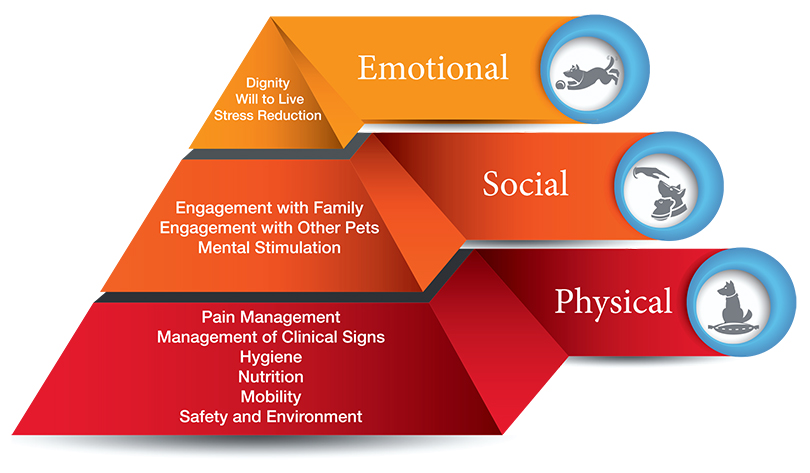Top 12 things you should know about AAHA’s End-of-Life Care Guidelines
The hardest part of loving a pet is having to say goodbye. For so many of us, pets are more than animals who live in our homes—they’re family. Deciding how to handle a beloved cat or dog’s final life stage—their last hours, days, weeks, or months—can be extremely challenging.
As animal lovers and medical professionals, veterinary teams want to support you when it’s time to make end-of-life decisions. That’s why AAHA collaborated with the International Association of Animal Hospice and Palliative Care to create the AAHA/IAAHPC End-of-Life Care Guidelines.
Top 12 things you need to know about these guidelines
- You still have some control of the situation. While you might feel powerless when your pet is diagnosed with a terminal disease, you can still be proactive about their care. Your veterinarian will tell you about the expected trajectory of the disease so, together, you can create a treatment plan for each step of the way.
- There are clear reasons a pet can be a candidate for palliative or hospice care. In the final life stage, dogs and cats generally have a terminal or ultimately fatal disease, a chronic or progressive disease, like end-stage kidney or heart failure, debilitating arthritis, a chronic disability like the inability to walk, or any combination of these. Since the medical issue itself is incurable, the goal of medications and treatment will be making every day as good as it can be.
- Just like in human hospice, animal hospice care focuses on relieving the patient’s suffering and supporting their caregivers. Hospice care should be provided—under veterinary guidance—from the time of a terminal diagnosis through death. This type of care seeks to relieve pain and anxiety using medications and can include euthanasia or hospice-supported natural death.
- Hospice-supported natural death is an alternative to euthanasia. Under the care of a veterinarian, death can occur naturally or with the assistance of medications administered by your veterinarian. This alternative is ideal for those who struggle with the decision to purposefully end their pet’s life, even if done humanely and for ethical reasons.
- Humane euthanasia is a peaceful process. The American Veterinary Medical Association (AVMA) has approved specific methods to minimize your pet’s pain, discomfort, and anxiety. Pet owners are often comforted by how quickly, quietly, and peacefully an animal passes away during euthanasia.
- Euthanasia can be a final act of love. While veterinary caregivers sympathize with how difficult making the decision to euthanize a beloved animal is, animal hospice doesn’t permit a pet to die without euthanasia unless effective measures are in place to alleviate discomfort under the care of a licensed veterinarian. Neglecting or ignoring a pet’s suffering is considered unethical and inhumane.
- Your veterinary team will carefully evaluate your pet’s end-of-life transition. Addressing your pet’s physical, social, and emotional needs are critical to maximizing your pet’s comfort and minimizing suffering. Your team may refer to the Animal Hospice Care Pyramid to guide their recommendations to you.

- Your veterinary team will customize a plan for your pet’s specific needs. This includes assessing your dog or cat’s level of pain as well as their ability to eat or drink, breathe without difficulty, eliminate appropriately, move about your home, and engage with surroundings and caregivers.
- Provide palliative and end-of-life care at home if at all possible. Ask your veterinarian how to maximize your pet’s quality of life. Simple modifications to your home can make a real difference in your pet’s comfort, such as altering slippery floor surfaces, improving accessibility to food and water, ensuring that bedding is comfortable, optimizing litter box location and design, finding an ideal home temperature, and maintaining sanitation and hygiene.
- Euthanasia can be performed in the veterinary hospital or at home. There are even veterinarians who exclusively practice in-home euthanasia, or will meet you at a park or beach if local laws allow. Your veterinarian will be sensitive to your wishes in such a tender time.
- Your veterinarian will continue to help after your pet’s death. Whether you chose burial, cremation, or a necropsy (autopsy), your veterinary team can make arrangements, and also offer suggestions for ways to cope with your loss. Many pet owners like to memorialize a pet by writing a letter to the pet, creating a photo album or journal about the animal, making jewelry or a charm from a pet’s ashes, or planting a memorial tree. If you like, your veterinarian can help you make a memorial item like a clay paw or nose print, or collect fur.
- Grief is a natural response to loss. It’s a dynamic process that changes over time. We often experience the same five stages of grief for pets that we do for human loved ones: denial, bargaining, anger, depression, and finally, acceptance. Please consider using resources available to grieving pet owners. You’re not alone.
What to ask your veterinarian about end-of-life care
- Is my pet suffering? How do you know? What is the best way to alleviate that?
- What modifications can I make to my home to increase my pet’s comfort?
- Are there indications that my pet is a candidate for hospice care?
- What are the advantages and disadvantages of humane euthanasia versus hospice-supported natural death?
- What are the pros and cons of euthanasia at home or in the veterinary hospital?
- How should I involve other family members, children, or pets in this process?
- Can you recommend resources for people grieving the death of a beloved pet?



